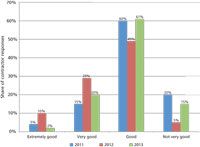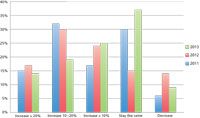Publication
Article
Pharmaceutical Technology
Stability Reigns in Contract Services
Author(s):
The PharmTech/PharmSource annual outsourcing survey results suggest that CDMOs may be getting complacent.

Visage/Getty Images; Dan WardA sense of relative calm seems to have overtaken the bio/pharmaceutical contract services industry in 2013. Bio/pharmaceutical companies say that their spending on contract services is still growing, but at a pace in line with the growth in their overall budgets. Service providers state that 2013 has been a good year, but it is not exceeding their expectations the way 2012 did.
Those are the impressions gained from analyzing the results of this year’s PharmSource Pharmaceutical Technology Outsourcing Survey, administered during June and July 2013. PharmSource and Pharmaceutical Technology have been conducting the survey for more than 10 years.
Modest spending growth

Figure 1: How will your contract services spending change this year? (All figures are courtesy of the author.)Responses from professionals at bio/pharmaceutical companies indicate that spending on contract services is up in 2013, but at a more modest rate than last year (see Figure 1). Just 30% of buy-side respondents indicated that spending this year will increase by 10% or more; in 2011 and 2012, 43% expected spending growth of 10% or more. Further, the number of respondents indicating that spending year-over-year will remain flat jumped from 27% in 2011 and 2012 to 37% in 2013.
The modest spending growth appears to reflect the overall growth in R&D spending. Approximately 40% of bio/pharma company respondents indicated that contract services spending is growing at the same pace as total R&D spending while those answering that services spend is growing faster or slower than total R&D spend are evenly split. These results are consistent with past years’ responses.

Figure 2: What will business be like for your company this year?Contract service providers appear to have come into 2013 with high expectations and while most haven’t been disappointed, those high expectations have left little room for upside surprises. Among sell-side respondents, 22% said they expect their volume of business in 2013 to be “very good” or “extremely good,” which is down sharply from the 39% in 2012 (see Figure 2). Further, 15% said business in 2013 was “not very good;” only 5% were so pessimistic in 2012.
Those subdued assessments of business conditions may reflect expectations more than actual performance. Only 28% of sell-siders view business in 2013 as “better than expected” while in the 2012 survey 49% were pleasantly surprised. Clearly, many service providers went into 2013 expecting strong performance while their expectations going into 2012 were more tentative.
Changing customer mix

Figure 3: Which client segment has been the best performing in your company this year?The most striking result in this year’s survey is the shift in where CDMOs say their business is coming from (see Figure 3). In this year’s survey, only 5% of sell-side respondents indicated that small bio/pharma companies have been their best-performing clients. That is a big drop from previous years.In the four years before 2013, the share of respondents indicating that small bio/pharma companies have been their best-performing segment averaged 22%. The drop undoubtedly reflects the difficult funding conditions that early-stage companies have faced in recent years.
Mid-sized and specialty pharma companies are again viewed as the best performing customer segments, with 30% of respondents citing them as their best performers. The perception of mid-sized companies as top performers has increased steadily over the past five years, and probably reflects the fact that those companies have steadily grown their R&D spending while activity in other customer segments has been more volatile.
The share of respondents citing generic-drug companies as their best-performing customers has also grown steadily; 28% of CMO respondents cited them this year. The reasons for this development need to be explored more. They may relate to the cost and quality advantages of contract service providers, but the trend may also reflect the growing number of new drug applications being filed by generic-drug companies.
Only 15% of CDMO respondents cited global bio/pharma companies as their best performers this year. That’s down from 20% in 2012 and continues a downward trend since 2009. This reflects the tepid growth in R&D spending at global bio/pharma companies and the reduced opportunities resulting from efforts to reduce the number of vendors that companies work with.
Concern over competitive threats

Figure 4: What is the single biggest risk to your business in the next two to three years? As the market for contract services has stabilized, service providers have moved from worrying about demand-related factors to concerns about the competitive environment (see Figure 4). Our 2013 survey saw a big decline in the share of sell-side respondents concerned about R&D spending cuts and supplier consolidation initiatives at global bio/pharma companies as well as a decline in those worried about funding for early-stage companies. Service provider concerns now appear to be focused on competitive issues, especially competition from suppliers in emerging markets and the implications of too much industry capacity.

Figure 5: Plans for sourcing in India and ChinaResults from buy-side respondents suggest those concerns may be misplaced. The 2013 survey found a slight decline in the share of bio/pharma company respondents actively sourcing from India and China, and a significant increase in respondents indicating they have no plans to source from suppliers in those countries (see Figure 5). Those responses are consistent with a general sense in the market that interest in sourcing from emerging-market supplies is waning due to eroding cost advantages, concerns about quality, and the complexity of overseeing suppliers halfway around the world.
While competition from emerging markets may be waning, the market overall continues to be competitive and service providers remain willing to deal. In this year’s survey, 52% of bio/pharma company respondents indicated that vendors are willing to cut price to get their business; this is the same percentage in the four previous surveys.
Modest outlook for 2014

Figure 6: How will your contract services spend change next year?Responses from bio/pharma company professionals suggest that 2014 should be another year of modest growth for contract service providers (see Figure 6). A full third (33%) of respondents expect their contract services spend to grow by 10% or more in 2014, which is promising but well below the 47% in last year’s survey that foresaw 10+% growth for 2013. Further, 37% don’t expect their spending to grow at all in 2014, which is up sharply from the 15% projecting no growth in 2012.
What it means
In our minds, 2013 represents a return to normalcy for contract services. The bio/pharmaceutical industry seems to have worked through the adjustments and uncertainties caused by the patent cliff, big mergers among the global bio/pharma companies, and the global financial crisis. If 2012 looked to deliver more upside surprises for contract services, that was mainly because the industry was finally benefiting from a general recovery in drug-development activity that many CDMOs didn’t dare budget for.
Still, there are some warning signs in the data that shouldn’t be overlooked. The dependence of the contract services industry on the overall level of development activity is hardly surprising, but experience has shown that development activity is cyclical. Big mergers, global financial market conditions, or waves of clinical candidate failures can abruptly disrupt development activity.
Today, preclinical and Phase 1 clinical research service providers are suffering from the dearth of early-development candidates brought on by funding constraints on early-stage companies and the restructuring of the R&D model at global bio/pharma companies. The paucity of preclinical and Phase 1 candidates will soon be felt by CMC (chemistry, manufacturing, and controls) service providers as the inventory of development candidates shelved during the financial crisis is worked off. Recent financial market developments, notably the reopening of the window for initial public offerings, may attract new capital to the industry, but it will be some time before the impact of that new money is felt.

Figure 7: How have you managed the number of contractors you work with?Another danger for contract service providers is that in good times like these, they can become complacent in service delivery and the acquisition of new business. The 2013 survey confirmed what we have seen in past years, namely that there is a wide gulf between clients and CDMOs in how they perceive the quality of their services. While the gap in expectations and perception will never be fully closed, the fact that it hasn’t narrowed over the five plus years since we started asking the question suggests that service providers have not done enough to improve service or set reasonable expectations.
The survey data also suggest that complacency is an issue in new business development. The level of new client prospecting seems to have gone down dramatically: in 2013, only 22% of CDMO respondents indicated that more than half of their proposals were going to new clients; in 2012, 39% indicated that most of their proposals were going to new clients. This is especially unfortunate because bio/pharma company respondents indicated some increased willingness to consider new service providers (see Figure 7).
Results from this year’s PharmSource--Pharmaceutical Technology Outsourcing Survey confirm the industry is experiencing a robust market for contract services. Whether it stays that way will partly depend on external developments, but also on the efforts of contract services providers themselves.
Jim Miller is president of PharmSource Information Services, Inc., and publisher of Bio/Pharmaceutical Outsourcing Report, tel. 703.383.4903, fax 703.383.4905, info@pharmsource.com, www.pharmsource.com.

Newsletter
Get the essential updates shaping the future of pharma manufacturing and compliance—subscribe today to Pharmaceutical Technology and never miss a breakthrough.





